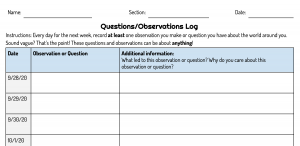

We’re continuing to describe the Boston Latin Science Fair and how GId transformed the design in ways that made a big impact on student learning. Today we’ll be talking about how they opened the unit and the effect it had on students.
The team planned for this Science Fair Project project to open up their school year. Unlike so many teachers who wait to do inquiry until AFTER all the “content is covered,” this team chose to start with inquiry, setting the tone for the year. Of course deadlines were considered, as well as how much time they had to give to these projects. They wanted the students to share their projects before winter break and wanted to ensure students had the time to do the work necessary to get there. With all of those factors playing in, they decided to start on Day One of school! And they discovered a few things along the way as they implemented their newly designed project.
What they found was that not only was Guided Inquiry Design a great way to guide students to find their own interests through curiosity, it served to create community as well. For the Open of the unit the team decided to draw on student’s Third Space. They wanted to help students think about what interested them about science by connecting their curiosities in their lived experiences. So they began with a weeklong observation. Science Teacher, Kelly Bagdonas describes it really well in this short video.
http://https://vimeo.com/542806232
As a result of this wondering and sharing, the students came to know each other through talking about the scientific observations they each had. They learned about each others families, their home lives, their pets, but not in a “icebreaker” forced kind of way. It occurred as interests arose and students got excited to tell about the connections that they were making. As they shared with peers and in the whole group.

As they connected their lives to science, they spoke intelligently about their observations and got to know one another and built community. What they learned was that, not only does GId serve the learning goals of thinking like a scientist, but relationships can be built through inquiry learning and through listening to others.
This also served as a culturally responsive practice. Students were connecting school to home in meaningful ways. Talking about their lives from their own personal perspective and recognizing that their input is valued in the school setting. This was particularly important for Covid times but, this will carry over to when the students come back to be with us as well. Taking time to know students builds community increases cultural awareness, and provides the open space for the deep learning to follow.
Leslie Maniotes, PhD
Author, Guided Inquiry Design